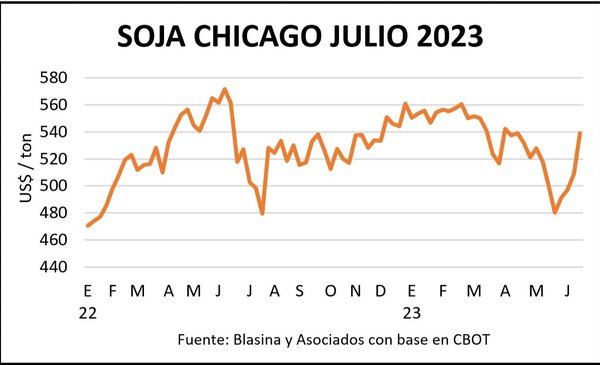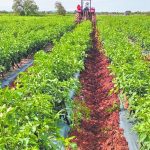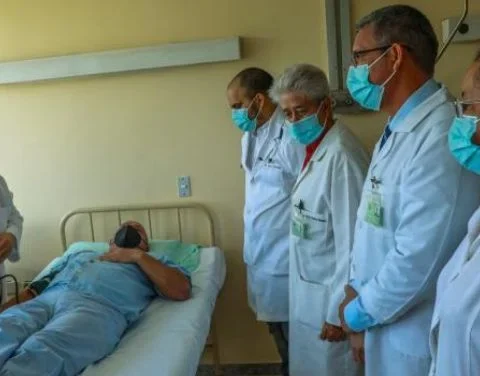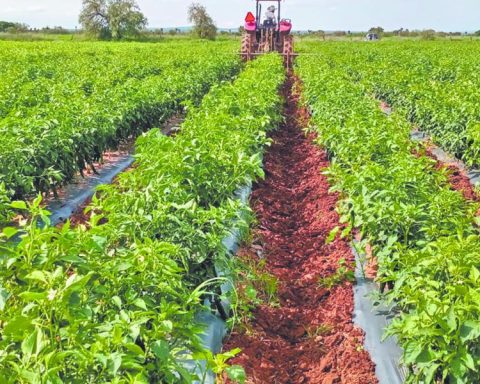He US grain market turned bullish with the biggest rise in several months. In uruguay the price of fat cattle continues to fall and the depressed values in China begin to be felt in the export price. The Wool was affected by the strengthening of the Australian currency and fell back below the $8 benchmark.
Soy 2024 at US$ 440
With 2024 soybeans reaching US$440 per ton, the best opportunity so far appears to close kilos of soybeans in a favorable input/output ratio.
This week’s rise was widespread in Chicago as drought areas expanded strongly and there is great uncertainty regarding rainfall ahead.
The weather in the growing areas of the United States is the great factor that is having a strong impact on the markets and led the July soybean position to rise almost US$ 30 per ton in the last week (+5.8%). to close this Friday at $538.85 in Chicago, the highest price since mid-April.
The August position rose 8.6% and November 11.5%, with a weekly gain of US$50 per ton.
This week the United States Department of Agriculture (USDA) corrected from 39% to 51% the proportion of soybean crops under drought conditions, well above 9% a year ago.
The rise also includes rapeseed, which reached US$445 per ton, which also creates an opportunity to close the first kilos of this harvest.
Agromarkets.
Wheat also rose strongly with funds in a long position and adverse conditions for the winter harvest in the United States (excess rains in producing states), as well as for Europe, with the drought advancing in France, Germany and Russia.
The December wheat position gained more than US$21 per ton this week (+8.8%) and closed at US$263 per ton this Friday. Strengthening wheat is supporting malting barley, which was below $225 and is reaching $260 a ton.
Wheat and barley plantings advance strongly in Uruguay which, based on forecasts, may be practically completed this month, which ensures a good yield potential, since everything is implemented on time.
fat steer in fall
The adjustment in the finance market deepens, with the steers below US$4 per kilo and expectations of the operators on how much more it can go down.
The industry maintains a cautious stance, with plants that at the end of the week stopped buying. “They say they can’t sustain those prices, you have to ask every day,” said Pablo Sánchez, from the Walter Hugo Abelenda desk and director of the Association of Cattle Shippers (ACG).
Special steers that on Tuesday were quoted from US$ 3.90 to US$ 3.95 in fourth scale, are now proposed between US$ 3.80 and US$ 3.90. This is the seventh consecutive week of adjustment, a downward path that began in early May.

Agromarkets.
For the best cows, prices are around US$3.70 and between US$3.80 and US$3.90 in the case of some very good heifers. The inputs range from 10 to 12 days, with disparity between plants.
Sánchez commented that there is some difficulty in placing the most general fat cattle. The offer of special lots is still very scarce.
Chinese demand for beef is limited and continues to pressure values. “China does not stop falling,” said a consulted industrialist, a correction that is beginning to be seen in the export price, with a marked weekly drop in the value per ton. It stood at US$4,326, well below the average of the last 30 days of US$4,598, according to provisional data from the National Meat Institute (INAC).

Agromarkets.
Given this international weakness and minimal availability of finished cattle, there are plants with temporary closures and licensing of personnel, as well as other industries with difficulties to operate normally due to lack of water to comply with the processes.
There is no pressure from the industry. The slaughter, in fact, was the lowest in the last seven weeks. With 37,385 cattle, it had its fourth consecutive week of decline. If compared to the same period last year, the adjustment was -31%.
The replacement market in private businesses shows some stabilitySanchez commented. The supply is moderate and the demand is selective. At the gates of winter, strong cattle are sought, with heavy carcasses. Prices are between US$1.40 and US$1.50 for the wintering cow depending on quality, and steers between US$1.80 and US$1.90. The values for calves of around 160 kilos range from US$1.90 to US$2. And the whole calf, demanded by exports and collectors, quotes between US$2.40 and US$2.50. Castrated calves, depending on the kilos, are around US$ 2.30.
In Uruguay Screen this week the results were uneven, with less demand for calves and breeding parts. Everything destined for quick wintering showed no placement problems, Carlos Jaso, from Escritorio Jaso & Jaso Negocios Rurales, a member of Screen Uruguay, told Tiempo de Cambio on Rural radio.
In lanares the work increased, but not so the prices. Businesses are around US$ 2.80 for lamb and lamb and, with higher supply, US$ 2.40 for sheep. Tickets are fast, about a week.
Sheep slaughter recovered and grew 29% compared to the previous week, which had been one of the lowest of the year.
Regarding sheep meat exports, the volume increases but the price continues on the floor. Last week there was a slight recovery in values, but within a clear downward trend, which continues to position sheep meat unusually below beef.
The weekly value was US$ 3,724 per ton. In the last 30 rolling days, it averaged US$3,682 per ton and has been on a downward streak since mid-May.
Wool market in decline
The strengthening of the Australian currency slowed the momentum that the wool market had cashed out last week and prices dropped in both US dollars and local currency.
The Eastern Markets Indicator (IME) lost 1% in dollars and closed at US$7.99, while in local currency the fall was 2.8% to close at AU$11.74 per clean base kilo. In the last two weeks, increased bank rates, the Australian dollar gained 5% against the dollar while the wool indicator fell 3%.
“This is an effective gain in export price, but it is not positive for those who sell locally every week,” said the Australian Wool Innovation (AWI) organization.

Agromarkets.
The percentage of sales was low, only 77% of the 39,672 bales offered.
Financial conditions discouraged demand, which remains stable but below usual levels at this time of the year, when the July recess is two weeks away and buyers must ensure stocks to sustain textile activity until mid-August.
The Chinese industry held a conference this week in which the main topics were innovation, investment in factories and the transformation of the traditional supply chain, as well as the need for China to improve the quality of its products to increase margins in the local market.
Chinese buyers were cautious and selective this week, while major Italian customers actively bid for the best quality fine wool lots and Indian buyers took advantage of low prices.
In fact, the finest wools fell the most, with losses exceeding 3% in US dollars from 18 microns onwards.
On the contrary, medium and mixed wools increased to 2.6% in the case of 26 microns and 2.2% for 28 microns.
Locally The Uruguayan Secretariat of Wool (SUL) reported operations for Merino batches of 20.8 and 20.9 microns at a price of US$ 5 per kilo dirty base for wool conditioned with green tap and RWS certification.

















